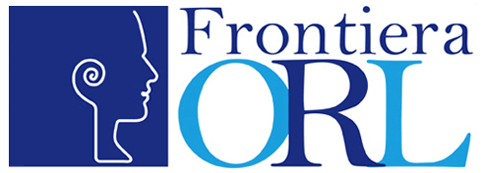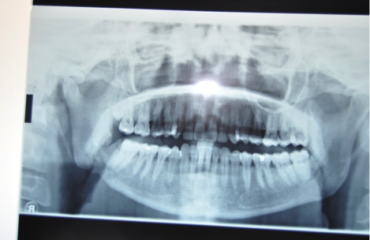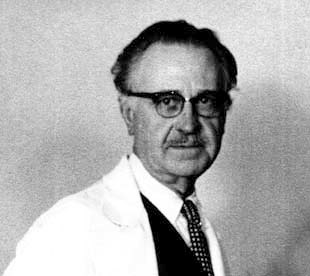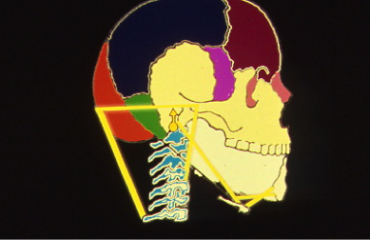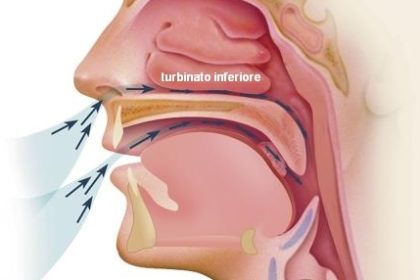
G. Tinelli, L. Lanza
U.O. Otorinolaringoiatria, Ospedale Civile di Voghera, A.O. Provincia di Pavia
Abstract
Minimally invasive surgery of the inferior turbinate has made over the past 15 years considerable changes and technological innovations to resolve respiratory obstruction respecting the physiology of the nasal cavity and resulting in a minimal discomfort. Following the minimally invasive surgery also the pharmaceutical industry has gradually developed medical device to aid healing of the nasal mucosa and thus to reduce possible side effects induced from any thermal damage. Most recent innovations are the preparations of hyaluronic acid and amino acids. Several studies show the effectiveness of this association of molecules at the level of the mucous membranes, especially of the oral cavity. However, there are still few studies on formulations for the nasal mucosa based on sodium hyaluronate and amino acids.
In this prospective study we evaluated the efficacy of a new nasal spray formulation containing sodium hyaluronate and amino acids (Rinoamin) in post-surgical clinical course of patients undergoing minimally invasive surgery of the inferior turbinate, even associated with septoplasty.
Introduction
Minimally invasive surgery of the inferior turbinate has undergone in the last 15 years considerable changes and technological innovations, developed by biomedical engineering in order to achieve an ideal technique to solve short and long term nasal obstructive symptoms, respecting the physiology of the nose and with minimal discomfort for the patient. So, from traditional techniques, which required general anesthesia and nasal packing , to minimally invasive techniques under local anesthesia and without nasal packing (1-8). With the advent of minimally invasive surgery also the pharmaceutical industry has gradually developed medical device to aid healing of the nasal mucosa and thus to reduce possible side effects induced from any thermal damage. Latest innovations are pharmacological preparations based on hyaluronic acid and amino acids. Hyaluronic acid (AI) is a non-sulphate glycosaminoglycan characterized by a non-branched polysaccharide chain consisting of repeated disaccharide units, formed in turn by residues of D-glucuronic acid (a derivative of glucose) and N-acetylglucosamine. It is almost ubiquitous in the human body and is one of the fundamental constituents of the extracellular matrix of connective tissues. It’s implicated in numerous biological processes, including wound healing (9). It is a molecule non-immunogenic (10) with antioxidant activity, viscoelastic and highly osmotic in solution. Its high polarity explain the high solubility in water. The AI is able to promote the healing process and is able to induce the expression of pro-inflammatory cytokines such as TNFa, IL1?, IL8, in dose-dependent way (11). It also has a modulatory effect of the inflammatory response (12). It is found in high concentration in the granulation tissue where it promotes cell migration and proliferation, and also the organization of granulation tissue itself. The AI has not direct mitogenic activity on fibroblasts (12), primarily responsible of the repairation of connective tissue, but it facilitates replication, induced by mitogenic factors, abundant especially in the first phase of inflammation. Low weight AI molecules induce tissues angiogenesis . High weight AI molecules have a bacteriostatic effect on some bacterial species including ActinobacillusActinomycetemcomitans, Prevotellaoris, Staphylococcus aureus, Propinibacterium acnes, Streptococcus mutans and Porphyromonasgingivalis (13).
Materials and methods
The study was conducted on 80 patients aged between 25 and 65 years (mean 40.78; median 41.2), of which 53 males and 27 females, who underwent surgery for decongestion of the inferior turbinate even associated with septoplasty at the Hospital of Voghera (PV) from 2011 to 2014. All patients were candidates for surgery because of nasal respiratory obstruction with chronic hypertrophic rhinitis resistant to medical therapy. Patients underwent decongestion of the inferior turbinate with radiofrequency after local anesthesia by contact with lidocaine 2% or surgical decongestion with microdebrider +/- septoplasty under general anesthesia. All procedures were performed under endoscopic vision. Inclusion criteria in the study were: nasal respiratory obstruction with chronic hypertrophic rhinitis lasting for at least three months and resistant to medical therapy, age> 18 years old, absence of systemic diseases or medical therapies in place capable of interfering with the healing process. Exclusion criteria are: nasosinusal polyposis, mellitus diabetes, asthma, systemic diseases for reasons related to the homogeneity of sampling. The 80 patients were distributed into two groups A and B of 40 patients each, depending on the post-operative nasal medicament used. Group A (study group) includes 40 patients who get local application of the new nasal spray Rinoamin 3 times /day for one month; group B (control group) includes 40 patients who get topical application of a nasal ointment based on vitamins with the same dosage. The application of the drug for both groups has been preceded by nasal washes.
Then postoperative checks were performed 48 hours, 7 days, 15 days and one month after starting intranasal treatment. The start of treatment coincides with the day of surgery for patients who underwent radiofrequency surgery of turbinate and with the day of the nasal unpacking for patients who underwent other types of surgery included in the study. Evaluated parameters were: healing time, re-epithelialization time of mucosa, pain with VAS, satisfaction of the patient, degree of respiratory obstruction with subjective NOSE TEST, and with psychophysical SNOT20 GAV test as indicator of the quality of life. The degree of nasal mucosa’s disepithelialization was quantified by assessing the amount endoscopically scabs and fibrin in the nasal cavity. The healing of the nasal mucosa and the degree of disepithelialization were evaluated with endoscopic postoperative controls. The degree of satisfaction was quantified on a scale from 1 to 4, respectively negative, modest, good and excellent. Statistical analysis was performed with T-student.
Objectives parameters are:
- Healing time;
- Disepithelialization of nasal mucosa.
Subjective parameters evaluated through questionnaires are:
- Pain: VAS;
- Satisfaction;
- Degree of respiratory subjective obstruction (NOSE test);
- Quality of life: SNOT 20 GAV questionnaire.
Results
Healing time after surgery of the nasal mucosa in patients of group A was an average of 14.68 days, while in Group B of 16.28 days (Chart 1).
| STUDY GR. (A) | CONTROL GR. (B)
T Test P studio/controllo < 0,05 |
| 14,68 gg | 16,28 gg |
Endoscopic evaluations of the nasal cavity showed a reduction in the degree of disepithelialization of nasal mucosa in both groups in postsurgical controls. From the comparison between the two groups the reduction of disepithelialization was greater in the study group with highly significant results at 7 days and 15 days. (Figure 2, Tables 2a, 2b).
T TEST
P study gr. <<0,05
P control gr. << 0,05
P study/control:
at 48 h >0,05
at 7 and 15 days <<0,05
at 1 month< 0,05
Table 2a
| Disepithelialization | ||||
| 48h | 7 days | 15 days | 1 month | |
| Study gr. | 52,9 | 23,1 | 3,9 | 0,6 |
| Control Gr. | 58,1 | 35,5 | 14,0 | 2,5 |
Table 2b
| Difference % | 48H | 7 days | 15 days | 1 month |
| Study / Control | 5,3% | 12,4% | 10,1% | 1,9% |
Pain in each group was reduced in postsurgical controls but this reduction is not significant at 48 hours after local therapy. The statistical comparison between the means of groups A and B for each control has rather significant differences. (Chart 3, Table 3a; Figure 4, Tables 4a and 4b).
T TEST
P study gr. <<0,05 at 7 and 15 days
(Presurgical/48h >0,05)
P control gr. << 0,05 at 7 and 15days
(Presurgical/48h >0,05)
P study/control >0,05
Table 3a
| Medie VAS | |||||
| pre-surgery | 48h | 7 days | 15 days | 1 month | |
| Study Gr. | 1,78 | 1,83 | 0,68 | 0,23 | 0,00 |
| Control Gr. | 1,88 | 1,85 | 0,88 | 0,33 | 0,00 |
Chart 4
Table 4a
| % VAS | |||||
| pre-surgery | 48h | 7 days | 15 days | 1 month | |
| Study Gr. | 17,75% | 18,25% | 6,75% | 2,25% | 0% |
| Control Gr. | 18,75% | 18,5% | 8,75% | 3,25% | 0% |
Table 4b
| Difference % | pre-surgery | 48h | 7 days | 15 days | 1 month |
| Gr A/Gr B | 1% | 0,25% | 2% | 1% | 0 |
The degree of patient satisfaction is increased by pre- to post-surgical controls in both groups, up to the fifteenth day since the start of local therapy. After one month there was an average stabilization in the degree of satisfaction in both groups, being greater in control group B. The comparison of mean values between the 2 groups for each control has highlighted significant differences at 48 hours, 7 days and 15 days (Chart 5, Table 5a; Figure 6, Table 6a, 6b).
Chart 5
T TEST
P study gr. <<0,05 at 48h, 7 and 15 days
P control gr. << 0,05 at 48h, 7 and 15 days
P study/control: <<0,05 at 48h,7 and 15 days; < 0,5 at 1 month
Table 5a
| SATISFACTION | |||||
| mean | pre-surgical | 48h | 7 days | 15 days | 1 month |
| STUDY GR. | 1,48 | 2,73 | 3,28 | 3,73 | 3,55 |
| CONTROL GR. | 1,40 | 2,13 | 2,63 | 3,28 | 3,18 |
Chart 6
Table 6a
| GRADO DI SODDISFAZIONE | |||||
| pre-surgical | 48h | 7 days | 15 days | 1 month | |
| study gr. | 37% | 68% | 82% | 93% | 89% |
| control gr. | 35% | 53% | 66% | 82% | 79% |
| Difference % | presurgical | 48H | 7 days | 15 days | 1 month |
| Study/Control | 2% | 5% | 16% | 11% | 10% |
Mancatabella 6b in inglese
The degree of subjective nasal respiratory obstruction quantified with NOSE test, is reduced in both groups to each control. The study group has lower average scores than the control group but there were no statistically significant differences at one month. (Figure 7, Tables 7a, 7b).
T TEST
P study gr. <<0,05
P control gr. << 0,05
P study/control <0,05
(at 1 month>0,05)
Table 7a
| % | pre-surgical | 48h | 7 days | 15 days | 1 month |
| STUDY GR. | 91,25 | 44,25 | 30,25 | 15,25 | 6,75 |
| CONTROL GR. | 85,25 | 53,38 | 40,13 | 24,38 | 10,63 |
Table 7b
| Difference % | pre-surgical | 48H | 7 days | 15 days | 1 month |
| study / control | 6% | 9,13% | 9,88% | 9,13% | 3,88% |
About the quality of life assessed by SNOT 20 questionnaire to 15 days (Figure 8, Table 8a) and 1 month (Figure 9, Table 9a), the study group has for each item of the questionnaire significantly lower values than the control group.
chart 8 Table 8a
| ITEM SNOT 20 | GR. A | GR. B | DIFFERENCE | |
| 1 | need to blow the nose | 43 | 81 | 38% |
| 2 | sneezing | 61 | 72 | 11% |
| 3 | nasaldrip | 30,5 | 74 | 43,5% |
| 4 | cough | 23,5 | 70,5 | 47% |
| 5 | retronasaldrip | 35 | 82 | 47% |
| 6 | secretions’ thickness | 25,5 | 64,5 | 39% |
| 7 | fulness | 3 | 4 | 1% |
| 8
T Test P study/control < 0,05 |
dizziness | 0 | 0 | 0 |
| 9 | earache | 2 | 1 | 1% |
| 10 | facialpain / pressure | 9 | 13,5 | 4,5% |
| 11 | difficulty to fallasleep | 14,5 | 31,5 | 17% |
| 12 | nocturnalawakenings | 13,5 | 30,5 | 17% |
| 13 | lack of restfulsleep | 9 | 21 | 12% |
| 14 | tiredwake up | 6 | 16,5 | 10,5% |
| 15 | tiring out | 7 | 13 | 6% |
| 16 | reducedproductivity | 8 | 14 | 6% |
| 17 | reducedconcentration | 7 | 28 | 21% |
| 18 | irritability / frustuation | 4 | 24 | 20% |
| 19 | sadness | 2 | 10 | 8% |
| 20 | embarassment | 7,5 | 32 | 24,5% |
chart 9Table9°
| ITEM SNOT 20 | GR. A | GR. B | DIFFERENCE | |
| 1 | need to blow the nose | 37 | 71,5 | 34,5% |
| 2 | sneezing | 50,5 | 62 | 11,5% |
| 3 | nasaldrip | 26 | 70,5 | 44,5% |
| 4 | cough | 17 | 62,5 | 45,5% |
| 5 | retronasaldrip | 22 | 71,5 | 49,5% |
| 6 | secretions’ thickness | 22 | 54,5 | 32,5 % |
| 7 | fulness | 0 | 0 | 0 |
| 8
T Test P study/control < 0,05 |
dizziness | 0 | 0 | 0 |
| 9 | earache | 0 | 0 | 0 |
| 10 | facialpain / pressure | 0 | 0 | 0 |
| 11 | difficulty to fallasleep | 7,5 | 22,5 | 15% |
| 12 | nocturnalawakenings | 3 | 19 | 16% |
| 13 | lack of restfulsleep | 2 | 16,5 | 14,5% |
| 14 | tiredwake up | 4 | 7 | 3% |
| 15 | tiring out | 5 | 9 | 4% |
| 16 | reducedproductivity | 5 | 14 | 9% |
| 17 | reducedconcentration | 15 | 30 | 15% |
| 18 | frustrazione / irritabilita’ | 10 | 40 | 30% |
| 19 | sadness | 6 | 30 | 24% |
| 20 | embarassment | 25 | 40 | 15% |
Discussion and conclusions.
AI is commonly used in some medical fields, such as orthopedy, oftalmology, oncology and odontoiatry. Many studies in odonthoiatric field showed effectivness of local medications with AI and aminoacids on oral scare tissue with fast healing and reduction of the pain compared to common emmolient gels (14-19). The action mechanism involves the stimulation of angiogenesis, promoting the formation of granulation tissue and collagen through the stimulation of the fibroblasts (20,21). The function in assisting the processes of tissue regeneration depends on its high biocompatibility, through a mechanical action of protective type, allowing, moreover, to maintain the ideal humidity conditions to the re-epithelialization of injured mucosa(16). These features make it ideal for the treatment of traumatic lesions of the mucous membranes. The pharmaceutical industry has therefore thought to extend the use of these AI preparations also to the nasal mucosa. It is in this context that fits the present study, designed to evaluate the efficacy of the new compound than using a common nasal ointment. The product used for this study is a medical device, formulated as a nasal spray. It consists of glycine, L-proline; L-Leucine, L-Lysine, Sodium Hyaluronate, purified water and excipients. In this study, no patient experienced adverse reactions to the drug. The study group (group A) presented healing times on average slightly lower than in the control group but this result is not highly significant. The degree of depithelialisation mucosa is instead on average lower in the study group compared to the control group with differences between the two groups highly significant at 7 days and 15 days from the beginning of local therapy.The pain was reduced in both groups from pre-operative to postsurgical control but the comparison between the two groups doesn’t show statistically significant differences. The % of patient satisfaction increased in both groups from pre-operative up to 15 days. After a month there is in both groups a reduction of the parameter, the higher in the control group. The difference between the two groups was highly significant at 7 days and 15 days from the beginning of local therapy. The degree of subjective nasal respiratory obstruction, evaluated trough NOSE test, is reduced in both groups and the scores obtained by the study group are on average lower than the control group, with statistically significant differences between the two groups at 7 days and 15 days from the start of local therapy. About the psychophysical outcome evaluated by SNOT20, the comparison between the two groups showed for each item average values significantly lower in the study group compared with the control group at both 15 days to 1 month after start of therapy. It is difficult to perform a comparison with literature datas because a product with the same composition in the spray formulation on the nasal mucosa has not been tested. Many are studies on the oral mucosa where it is evident that the association sodium hyaluronate and amino acids acts as an aid in the healing process of the oral mucosa. The conclusion, based on the data obtained, shows that we may advise the investigational product in the postoperative intranasal treatment to reduce the degree of disepithelialization of the nasal mucosa. The product seems to have a positive effect also on satisfaction, on reducing the subjective sensation of nasal obstruction and on psychophisical outcome. It does not seem suitable for treatment longer than 15 days. The post-surgical pain is influenced by the drug in the study.
